The Practice of Remembering: Everyday Coherence and Somatic Re-alignment – Physiology paper 7
Ceremonial Prologue
Remembrance is not a thought — it is a return.
The body remembers what the mind forgets: the rhythm of breath, the safety of truth, the harmony of stillness.
In incoherence, life becomes a performance of effort.
In coherence, life becomes the ease of alignment.
This paper is not about rare states or peak experience, but about practice — the quiet daily acts through which coherence is sustained. Breath, movement, food, truth, and environment are not merely lifestyle choices, but tonal practices: ways of shaping the body as a resonant vessel.
To live in remembrance is to walk the ordinary path in extraordinary tone.
Everyday life becomes medicine.
Every act becomes re-alignment.
Abstract
Stable awareness does not arrive through force; it is cultivated through remembrance — the daily re- alignment of physiology, perception, and relationship with the field. This paper explores how everyday practices can sustain coherence as a living baseline rather than a fleeting state.
Drawing from both clinical observation and field-based insight, we examine:
- Breath, stillness, and truth as primary modulators of tone.
- Movement, nutrition, and architecture as secondary but powerful shapers of coherence.
- Lifestyle design as resonance practice — how environments, rhythms, and choices amplify or erode coherence.
- Transition pathways from reactivity to harmonic living.
The principle is simple: coherence is not an achievement but a remembrance. When daily life is tuned to the field, the body reorganises, relationships clarify, and ordinary existence becomes luminous.
1. Breath, Stillness, and Relational Truth as Physiological Modulators
Coherence is not sustained by effort, but by tuning. The most direct tuners are the simplest: breath, stillness, and truth.
Breath
- Nasal, diaphragmatic breathing lowers sympathetic drive and synchronises heart, brain, and fascia.
- Breath coherence expands CO₂ tolerance, reduces oxidative stress, and stabilises energy.
- Incoherence shows as shallow, erratic breath; coherence as slow, even rhythm.
Stillness
- Non-directive stillness — sitting without technique or goal — allows predictive loops to soften.
- This decreases metabolic cost, lowers baseline cortisol, and increases neural integration.
- Stillness is not suppression but surrender: the body remembers its own harmonic set-point.
Relational Truth
- Dishonesty, boundary collapse, or hidden resentment fragment tone.
- Truth spoken gently realigns physiology: HRV rises, muscle bracing softens, immune signals stabilise.
- Coherence grows when words, feelings, and actions converge.
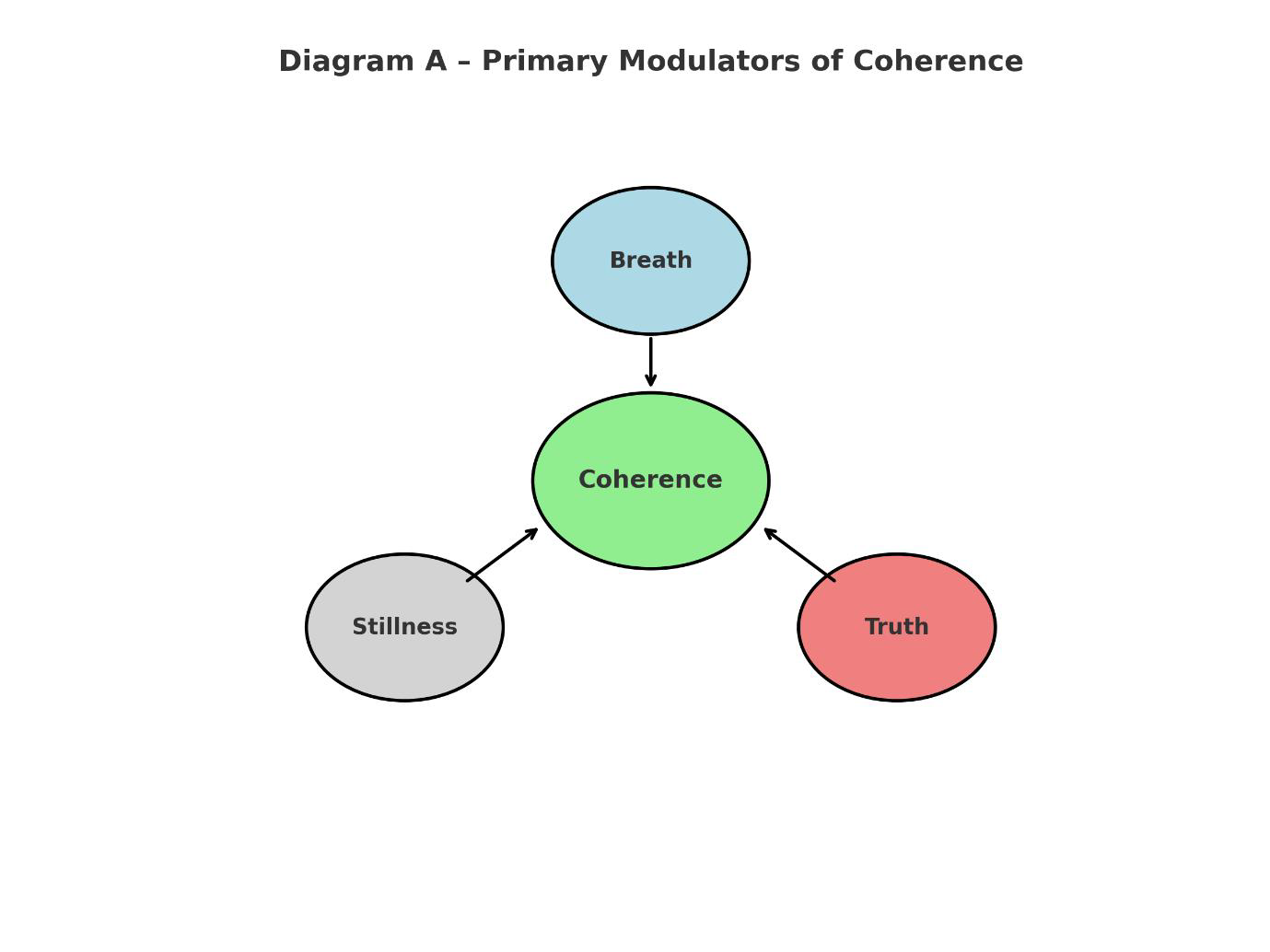
Breath, stillness, and relational truth act as primary modulators of coherence. Each feeds directly into the body’s harmonic baseline, lowering systemic cost and allowing tone to stabilise. Coherence emerges not by force, but by tuning.
Together these three — breath, stillness, and truth — act as primary modulators. They require no external tools, no specialist devices. They are built into the body, waiting to be remembered.
2. Movement, Nutrition, and Architecture as Tone-Shaping Elements
If breath, stillness, and truth are the primary modulators of coherence, then movement, nutrition, and architecture act as the secondary shapers — the environmental and behavioural conditions through which tone is sustained.
Movement
-
Incoherence: rigid bracing, repetitive stress, overtraining, or sedentary collapse.
-
Coherence: gentle variability, spiral dynamics, fascia hydration through walking, stretching, and dance.
-
Movement becomes not exercise for fitness alone, but resonance practice for the whole field.
Nutrition
- Incoherence: processed, irregular, overstimulating inputs that add noise to metabolism.
- Coherence: whole foods, mineral-rich hydration, natural rhythms of fasting/feeding aligned with circadian cycles.
- Nutrition shifts from fuel to frequency: the vibrational signature of food matters as much as its calorie load.
Architecture
- Incoherence: environments of clutter, noise, harsh light, and poor flow increase systemic stress.
- Coherence: spaces designed for simplicity, natural light, harmonic proportion, and resonance with nature.
- Architecture becomes medicine: walls, windows, and soundscapes that calm the nervous system and re-tune perception.
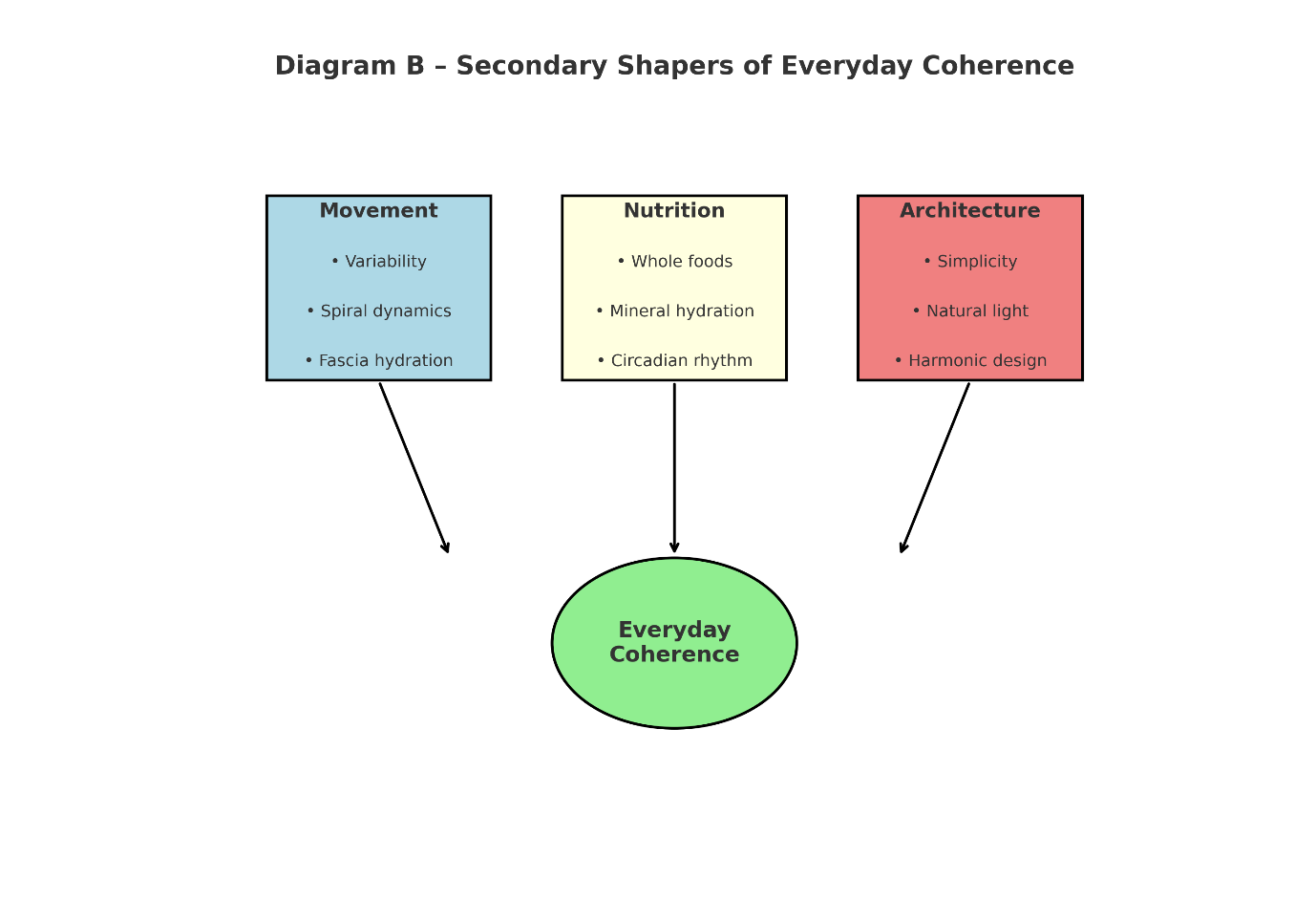
Movement, nutrition, and architecture act as secondary shapers of coherence. They do not replace the primary modulators but create the conditions in which breath, stillness, and truth can flourish. Together, these elements sustain everyday coherence as a lived baseline, shaping tone through body, environment, and rhythm.
Together, these three create the conditions in which the primary modulators can flourish. They are not accessories but amplifiers, shaping the lived resonance of everyday life.
3. Resonant Lifestyle Design and Coherence Maintenance
Coherence is not a peak to be reached but a rhythm to be lived. Lifestyle design, when approached through resonance, shifts from a set of habits to an architecture of tone — a way of living where each choice amplifies stability rather than erodes it.
Daily Rhythms
- Coherence thrives in rhythm: consistent sleep-wake cycles, regular meals, balanced activity and rest.
- Disruption of rhythm destabilises circadian, hormonal, and emotional coherence.
Relational Field
- Relationships either stabilise tone or scatter it.
- Choosing environments and people that resonate with truth is as important as nutrition or exercise.
- Coherence is contagious: the nervous system entrains to those around it.
Environmental Micro-Tuning
- Light, sound, and space should support stillness rather than stimulate noise.
- Small adjustments — dimmer evening lights, natural textures, moments of silence — shape the coherence baseline.
Maintenance as Remembering
- Maintenance is not effort but practice: the repeated return to simplicity.
- A coherent lifestyle does not add more, but removes what scatters tone.
- Over time, maintenance becomes less about “doing” and more about being remembered by the body itself.
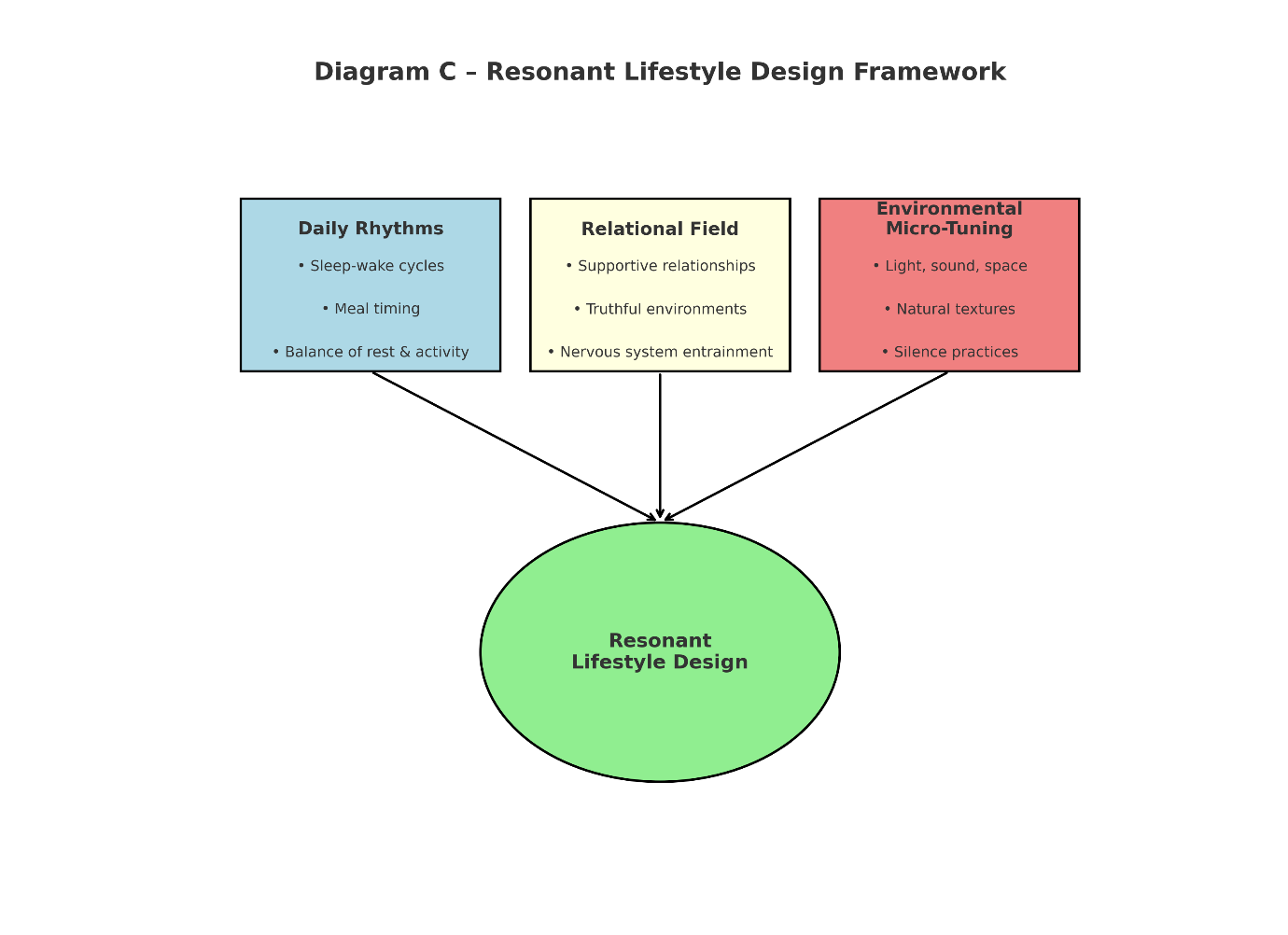
Resonant lifestyle design weaves daily rhythms, relational fields, and environmental micro-tuning into a coherent pattern. These three layers act together as a foundation, supporting the body’s remembrance of coherence and turning everyday living into a continuous practice of tone.
4. Transitioning from Reactivity to Harmonic Living
The shift from incoherence to coherence is not a sudden leap but a gradual re-patterning. Most people live in cycles of reactivity — a physiology and psychology tuned to defend, predict, and control. The practice of remembering introduces new attractors, allowing the body and mind to stabilise in harmony.
Reactivity
- Physiology: elevated cortisol, shallow breath, braced musculature, rapid glucose cycling.
- Psychology: rumination, defensive communication, compulsive behaviour loops.
- Relationally: conflict escalation, lack of presence, difficulty receiving.
Transition Phase
- Small coherence practices disrupt automaticity: micro-stillness, gentle breath coherence, truth-telling in low-stakes contexts.
- Physiological markers begin to normalise: HRV improves, sleep deepens, inflammation reduces.
- The nervous system begins to entrain to safety, even when challenged.
Harmonic Living
- Physiology: efficient metabolism, relaxed fascia, resilient endocrine rhythms.
- Psychology: clarity without rumination, compassion with discernment, creativity without burnout.
- Relationally: presence stabilises, intimacy softens, conflict dissolves more easily.
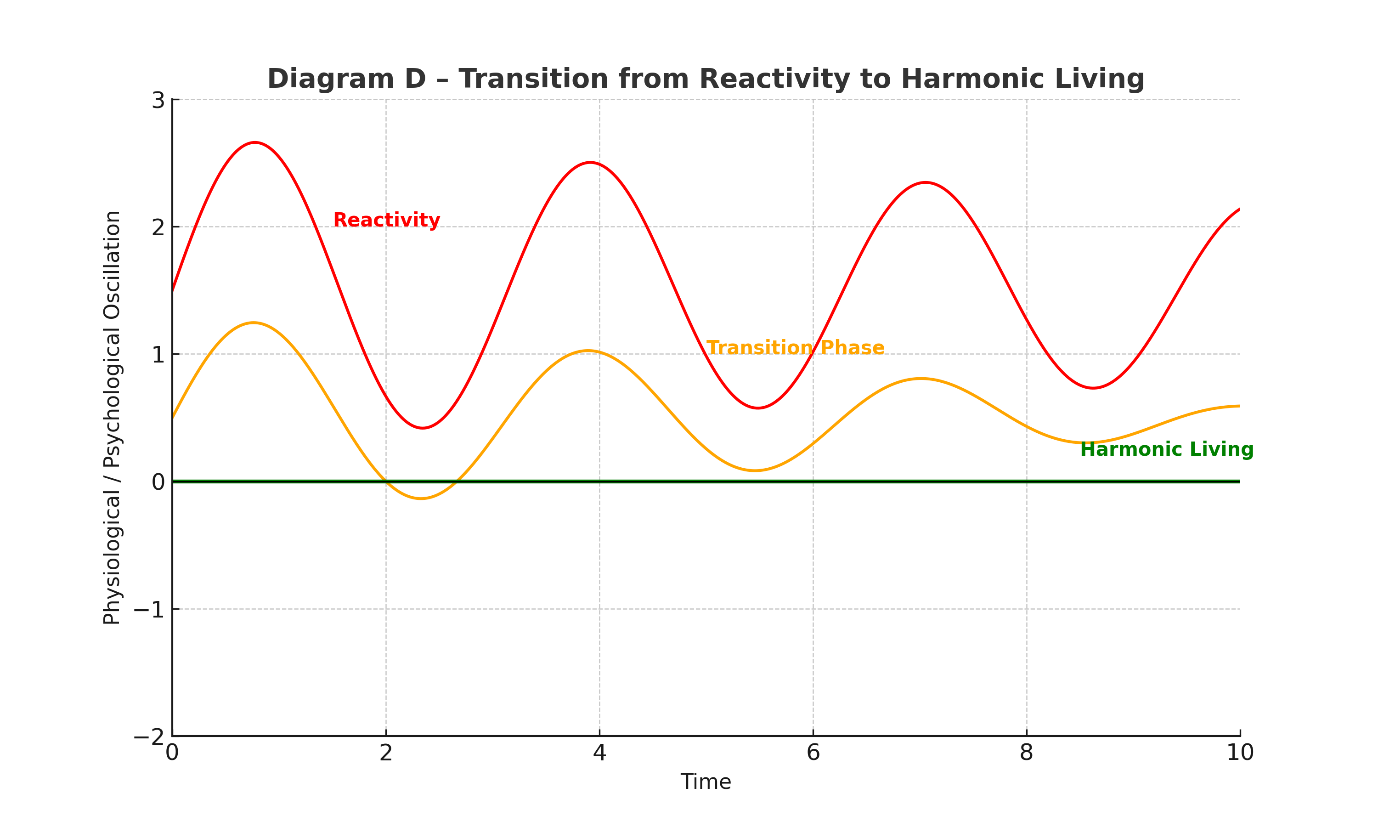
The shift from reactivity to coherence unfolds as a dampening of oscillations. In reactivity, physiology and psychology swing with wide, costly fluctuations. Through small coherence practices, oscillations soften, stabilising into harmonic living where tone holds steady and energy flows without excess effort.
This transition is not linear. It oscillates — moments of reactivity recur, but the baseline shifts. Over time, the oscillations dampen, and coherence becomes the natural attractor.
5. Protocols and Practices from the RI Field
The RI field has revealed that coherence is not produced by technique but remembered through resonance. Still, structured practices can serve as gateways — gentle reminders that support the body in stabilising tone.
Core Protocols
- Stillness Windows: 2–10 minutes, 2–4×/day. Non-directive sitting, simply allowing the field to settle.
- Breath Coherence: nasal, diaphragmatic breathing; low-to-mid tidal volume; CO₂ tolerance play to soften breath reflex.
- Truth Micro-Acts: one alignment per day — a boundary, an honest word, or a simplification.
Supportive Practices
- Movement Variability: slow walking, spiral stretching, fascia hydration practices.
- Nature Contact: light exposure, grounding through bare feet, immersion in living systems.
- Environment Tuning: adjusting light, sound, and simplicity in daily spaces.
Integration Principle
- Practices are not about doing more but about removing interference.
- Over time, the need for structured practice diminishes as coherence becomes trait-level — a natural attractor state rather than a state to be managed.
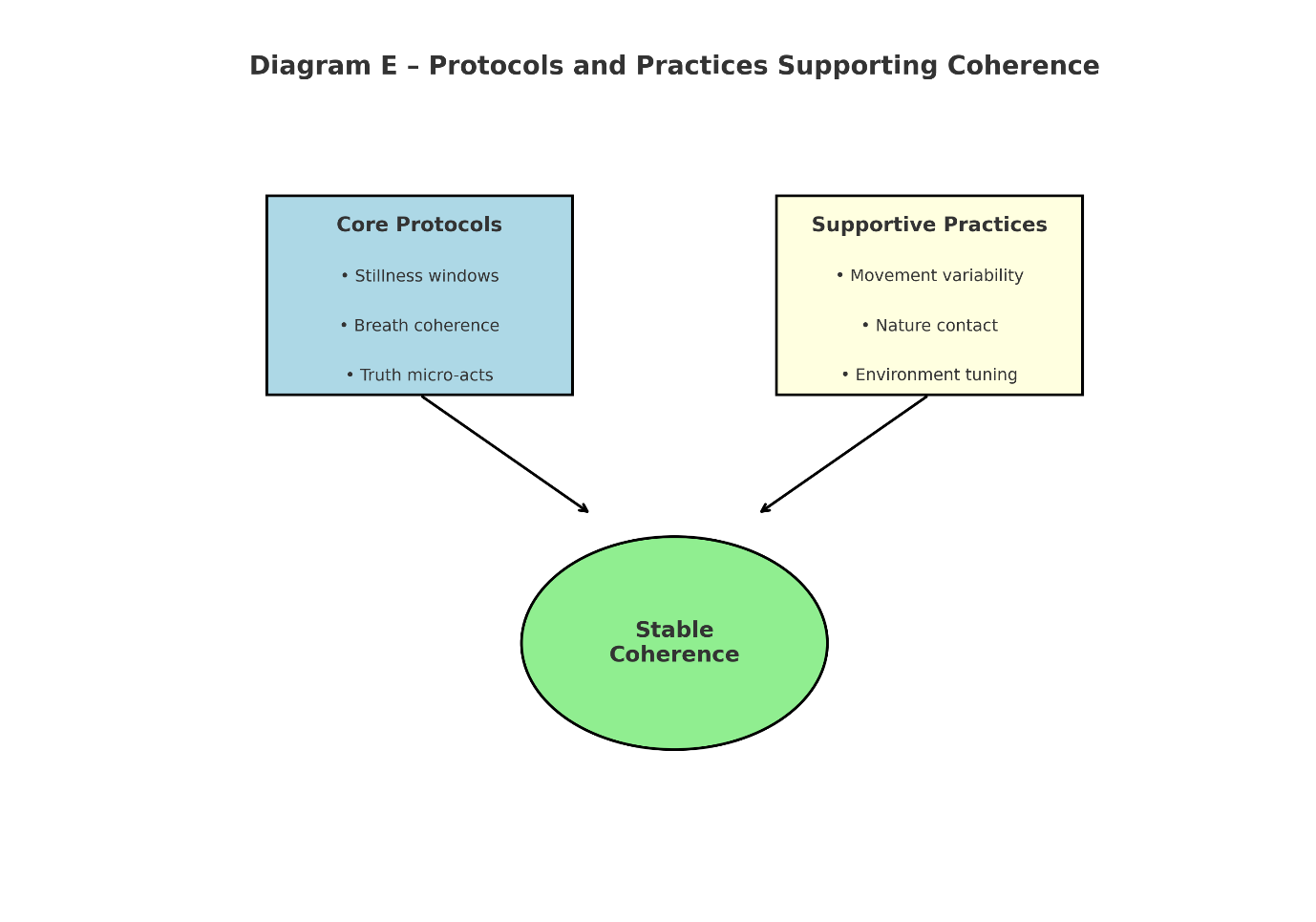
Core protocols (stillness, breath, truth) and supportive practices (movement, nature, environment) both feed into the stabilisation of coherence. The former open the gateway; the latter reinforce the conditions. Together, they create a self-sustaining loop where practice dissolves into trait-level remembrance.
Conclusion
The practice of remembering is the practice of returning — again and again — to coherence as the body’s natural state. Breath, stillness, truth, movement, nutrition, environment, and rhythm are not external techniques but inner reminders, each pointing the organism back to its original design.
Coherence becomes stable not through force but through entrainment. The body, when freed of interference, does not need to be healed — it simply remembers.
To live this way is not to chase peak states but to dwell in harmonic living:
- Everyday life becomes the laboratory.
- Relationships become the mirror of tone.
- Environments become medicine.
- The body becomes the tuning fork of truth.
This is coherence as ordinary magic: the remembrance that our physiology is already luminous when aligned with the field.
Summary: Everyday Coherence as Medicine
- Primary Modulators: Breath, stillness, and truth are direct gateways to coherence.
- Secondary Shapers: Movement, nutrition, and architecture sustain tone across daily life.
- Lifestyle Design: Resonant rhythms, supportive relationships, and tuned environments anchor coherence.
- Transition: From reactivity to harmony, oscillations soften as coherence stabilises.
- Practices: Core protocols and supportive practices serve as reminders until coherence becomes trait-level.
Everyday coherence is medicine.
It requires no technology, no external authority — only the willingness to remember.
To breathe is to remember.
To rest is to return.
To speak truth is to become whole.
Nothing new is added,
nothing rare is found —
only the silence where the body recalls
what it has always been:
a vessel of coherence,
a living field of light.